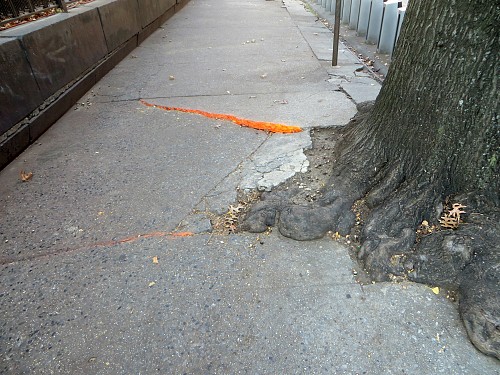Replacing and Repairing Root-Damaged Sidewalks
 Generally, my neighborhood is a safe and quiet place to walk my baby. But in a couple of spots, trees have pushed pieces of the sidewalk up into stroller launching ramps or major stumbling blocks. In one case, the sidewalk block heaves up at a 45-degree angle, leaving a vertical gap of about one foot.
Generally, my neighborhood is a safe and quiet place to walk my baby. But in a couple of spots, trees have pushed pieces of the sidewalk up into stroller launching ramps or major stumbling blocks. In one case, the sidewalk block heaves up at a 45-degree angle, leaving a vertical gap of about one foot.
Though the busted sidewalk is merely an inconvenience for me, it is a safety hazard for others and a dangerous problem for those in wheelchairs. Moreover, tackling the problem incorrectly can lead to other serious issues. A triple fatality in Ohio in 1990 was connected with a falling tree that had been destabilized when its roots were cut for a construction project.
If you are responsible for (and liable for accidents on) the sidewalk by your house, you need to know how to repair or replace the sidewalk, redirect the roots and plant the right way to avoid future problems.
Repair the Sidewalk
For minor movement and damage, several repair methods might work:
• The simplest and least attractive option is an asphalt wedge to bridge small gaps and create a smooth, if not flat, transition from main sidewalk to the broken, heaved edge.
• If the displacement is less than one inch, consider grinding down the raised edge.
• For larger displacement, you can remove the damaged sidewalk and re-pour the concrete into a bridge over the roots. Again, the sidewalk ends up less flat, but there are no abrupt tripping hazards.
• In other cases, it could make sense to redesign a portion of the sidewalk to curve around the offending roots.
Replace the Sidewalk
On the other hand, it might be a better idea to hire a contractor and replace the concrete sidewalk entirely. Asphalt is cheaper and more flexible than concrete, albeit less attractive. Landscape pavers are more expensive and better-looking than concrete, but non-porous pavers also could fall prey to tough, expanding roots. Still, it is easier to adjust and reset individual pavers than a large slab of concrete sidewalk.
A new alternative is a rubber sidewalk. This material, comprised primarily of recycled tires, is flexible and porous, allowing plenty of water to seep down to the roots. Advocates say rubber sidewalks are softer and safer in the event of a fall, as well. Also, gum doesn’t stick to rubber sidewalks, and cigarettes won’t burn them.
Divert the Roots
Of course, problems will just continue if you don’t get to the root(s) of the problem. Install barriers and appropriately care for trees to minimize the damage from roots.
Some research suggests that tree roots generally avoid the dry, sandy and compacted soil under sidewalks. However, the roots will grow into these spaces if trees are planted too close to the sidewalk or if they get desperate for water. If roots develop under the sidewalk, they will expand and reach toward the surface under cracks and expansion joints, where water is likely to drain into the soil.
To keep trees happy and adequately watered, add up to four inches of mulch around their base, and avoid herbicides. Water deeply and regularly during droughts but don’t fertilize or water too much. This just taunts the tree into establishing new growth that it can’t support.
You can also install three types of root barriers between sidewalks and trees to divert the roots. The most common root barrier is simply a wall made of plastic or other impermeable material that blocks the roots and direct them downward. These barriers must be planted at least 18 inches deep to be effective, and they may cause problems by blocking the transfer of water and nutrients.
A second option is nylon or copper screens that allow water and nutrients to pass through, and trap roots in small holes where they cannot grow. The third option is landscape fabric treated with root-inhibiting herbicides, such as Bio-Barrier.
Plant More Suitable Trees
Of course, the best way to prevent problems is to plant less problematic trees, and keep them farther from the sidewalk. Large trees should be planted 25 feet from the sidewalk if possible. Virginia Cooperative Extension offers this list of trees that are safer to plant near concrete, and trees to avoid.
By planting the right trees and caring for them properly, as well as blocking root growth and performing necessary repairs and replacement, you can avoid the hazards and lawsuits of root-damaged sidewalks.
Updated March 8, 2018.
Related Articles
Looking for a Pro? Call us (866) 441-6648

Landscaping Average Costs
Landscapers Experiences

Rotted Fence Repair Taken Care Of Fast And Efficiently

Outstanding Job On A New Concrete Driveway



